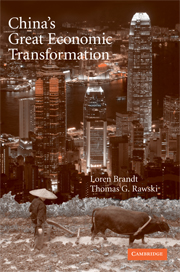Book contents
- Frontmatter
- Contents
- List of Figures
- List of Tables
- Contributors
- Acknowledgments
- Map
- 1 China's Great Economic Transformation
- 2 China and Development Economics
- 3 China in Light of the Performance of the Transition Economies
- 4 A Political Economy of China's Economic Transition
- 5 The Demographic Factor in China's Transition
- 6 The Chinese Labor Market in the Reform Era
- 7 Education in the Reform Era
- 8 Environmental Resources and Economic Growth
- 9 Science and Technology in China
- 10 The Political Economy of Private Sector Development in China
- 11 The Role of Law in China's Economic Development
- 12 China's Fiscal System: A Work in Progress
- 13 Agriculture in China's Development: Past Disappointments, Recent Successes, and Future Challenges
- 14 China's Financial System: Past, Present, and Future
- 15 China's Industrial Development
- 16 China's Embrace of Globalization
- 17 Growth and Structural Transformation in China
- 18 Income Inequality during China's Economic Transition
- 19 Spatial Dimensions of Chinese Economic Development
- 20 Forecasting China's Economic Growth to 2025
- Index
2 - China and Development Economics
Published online by Cambridge University Press: 24 May 2010
- Frontmatter
- Contents
- List of Figures
- List of Tables
- Contributors
- Acknowledgments
- Map
- 1 China's Great Economic Transformation
- 2 China and Development Economics
- 3 China in Light of the Performance of the Transition Economies
- 4 A Political Economy of China's Economic Transition
- 5 The Demographic Factor in China's Transition
- 6 The Chinese Labor Market in the Reform Era
- 7 Education in the Reform Era
- 8 Environmental Resources and Economic Growth
- 9 Science and Technology in China
- 10 The Political Economy of Private Sector Development in China
- 11 The Role of Law in China's Economic Development
- 12 China's Fiscal System: A Work in Progress
- 13 Agriculture in China's Development: Past Disappointments, Recent Successes, and Future Challenges
- 14 China's Financial System: Past, Present, and Future
- 15 China's Industrial Development
- 16 China's Embrace of Globalization
- 17 Growth and Structural Transformation in China
- 18 Income Inequality during China's Economic Transition
- 19 Spatial Dimensions of Chinese Economic Development
- 20 Forecasting China's Economic Growth to 2025
- Index
Summary
We view development economics as a set of empirical generalizations, paradigms, and tools that tell us something about why large differences in productivity and income within and among countries, social groups, and classes seem to persist. How does China fit into the received views of development economics? In answering this question the cup overfloweth with materials, so no attempt is made to be exhaustive. We begin in Part A by using comparative statistics of developing and developed countries to help understand China's present position and its growth experience since 1978. Ensuing sections take up selected topics where development economics and China's development experience intersect. Part B looks at governance issues in a comparative framework, focusing on corruption as a phenomenon that brings together many features of administration that are common across countries. Part C examines the rural sector, focusing on agricultural productivity and land tenure, and Part D reviews the uniquely East Asian phenomenon of rural industrialization. Part E concludes.
CHINA'S COMPARATIVE ECONOMIC PERFORMANCE: A QUANTITATIVE LOOK
How do China's economic performance and structure compare to those of other developing countries? In this section we situate China within the developing world, using comparative measures that are in some cases straightforward and in others somewhat controversial. Jan Svejnar's contribution (see Chapter 3) to this volume contains tables allowing similar comparisons with the transition economies. Variables examined include demographic, environmental, and energy indicators, economic data from national income and product accounts, Gini coefficients and related distributional measures, and selected human capital information.
- Type
- Chapter
- Information
- China's Great Economic Transformation , pp. 27 - 67Publisher: Cambridge University PressPrint publication year: 2008
- 11
- Cited by



